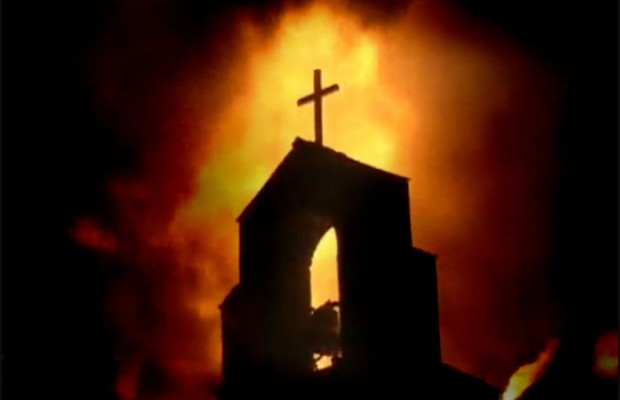Church Burnings and Southern Resistance — Is It 1963 Again?

This lesbian minister laments how disconnected the equality efforts for different groups — for blacks, women, and gays — currently feels.
I am a child of the Black Church. And like so many of my African American LGBTQ brothers and sisters we continue to have a troubled relationship with our places of worship. But like so many of them, I, too, am unsettled by the news of this recent spate of church burnings. None of the church burnings have been labeled as hate crimes- yet I cannot help but notice these church burnings are occurring suspiciously in rapid succession following the Charleston black church massacre, which left nine dead-including its senior pastor. The day before the church massacre, exactly one hundred and ninety-three years prior, “Mother” Emanuel African Methodist Episcopal Church was burned to the ground due to the racial violence of a mob of white slave owners. Mother Emanuel, however, rose from her ashes soon after the Civil War in 1865, and the doors of the church has been open and welcoming ever since, even with this recent incident.
In discovering that the motive of Dylann Storm Roof, 21, the neo-Confederate behind the Mother Emanuel massacre, was another Civil War. Sadly, the sudden rash of church burnings is one more persistent reminder of why during Antebellum America, hush harbors were places where my enslaved ancestors gathered in secret to worship free of tyranny. How little it seems has changed.
This particular act of domestic terrorism by Roof focuses a sharper lens on how the first shot fired during the American civil war at Fort Sumter near Charleston, SC in 1861 is still being felt one hundred and fifty years after its conclusion. From white slave owners, the Klu Klux Klan, to present-day white supremacist groups, African-Americans’ desire to obtain life, liberty and the pursuit of happiness have continually met with acts of violence.
If we thought Obama’s Millennials would be less racist than their ancestors, Roof quickly disabuse you of such a notion with the vitriol expressed in his manifesto, harkening back to Jim Crow America with its lynchings and church burnings. With the 1963 bombing of the 16th Street Baptist Church in Birmingham, Alabama killing four little African American girls-and thought be of a distant past-let us not forget the burning of the Macedonia Church of God in Christ in Springfield, Massachusetts just hours after Obama was elected that historic night of November 2008 as our country’s first African American president.
News came again of another church burned to the ground. And I was both outraged and frightened for these worshippers. It was Mt. Zion AME Church in Greeleyville, SC, just 65 miles north of Mother Emanuel. The first time the church was burned to the ground was in 1995 by a former Klansman, during 1990’s era of black church burnings. In 1996, President Clinton attended the church’s dedication ceremony rebuilt in the aftermath. The F.B.I. suspects the cause is lighting, but the church’s parishioners suspect otherwise.
With these recent rash of black church burnings, there has been a massive recruitment effort by the KKK, and Confederate flags have been flying off shelves in some Southern stores. As a church body now on terrorist alert, I stand in an awkward place — like many of my African-American LGBTQ brothers and sisters — as our places of worship rightly rail against these racist acts of church burnings, as well as unarmed black males gunned down by police and mass incarceration, they’re also blasting the recent Supreme Court ruling of Obergefell v. Hodges, legalizing same-sex marriage in all 50 states. I was told by several senior parishioners that most black churches showed no jubilation in the 1967 Supreme Court case of Loving vs. Virginia, declaring anti-miscegenation laws unconstitutional, as if it’s some sort of consolation. Sadly, with civil rights struggles in this country — by blacks, women, and gays — primarily understood and demonstrated as tribal and unconnected rather than intersectional and interdependent of each other, I orbit in overlapping worlds, yet home to none.
These church burnings point to what is troubling not only within the DNA of our country, but, also, within the souls of ourselves. African American gay icon James Baldwin wrote in “The Fire Next Time,” “I imagine one of the reasons people cling to their hates so stubbornly is because they sense, once hate is gone, they will be forced to deal with pain.”
These flames of hatred will never be extinguished until we dismantle both structural and personal acts of discrimination, whether in the name of God or the heritage of the Confederate flag.
